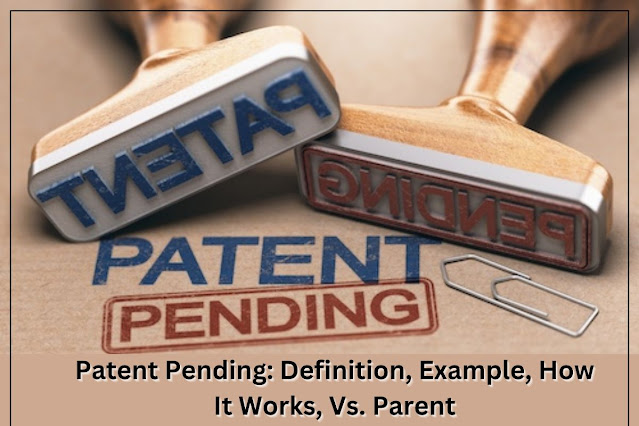Patent Pending: Definition, Example, How It Works, Vs. Parent
What Is Patent
Pending?
As
a designation of the inventor's intent to grant exclusive rights to use, selling
a patent, or license a product, the phrase patent pending is displayed
on the product. Provisional patents are filed with the United States Patent and
Trademark Office (USPTO).
The
patent-pending notice warns possible copycats that if and when the patent is
approved, they could be sued for copying the idea. As a result, any later
application to patent a substantially identical idea would have priority over
the newly filed patent application.
A
patent is usually granted for a process or design that is unique.
Example of Patent Pending
Near-identical
inventions can be granted patent
pending status repeatedly before a patent is awarded and the invention
goes to market, if ever.
A
new product idea has been developed by an entrepreneur named Joe. After
conducting a patent search, he finds that a nearly identical invention has
already received a provisional patent.
The
provisional patent has not been renewed a year later, according to Joe's search
in the patent database. A provisional patent is filed immediately after he hires
a patent attorney.
A
prototype of Joe's new product is manufactured after he files for a provisional
patent and is marketed with a patent pending sticker. However, Joe discovers
that mass-manufacturing this product requires too many regulatory and capital
improvements after the product hits the market.
It
is abandoned after a year, and Joe's idea is made available again.
Patent Pending Status: How to File
Applicants
for provisional patents file documents with the Patent Office with the U.S.
Patent Office and establish a priority filing date. A full application must be
filed within one year after the expiration date.
While
the inventor is deciding whether to patent services for the product
or process, he can attach the patent-pending label to it.
Patent Pending Infringement
Inventors
have little control over copycats while their ideas are patent-pending. The
inventor, however, is entitled to take legal action upon approval of the patent
company.
Penalties
may also be imposed for violations that occur after a patent is granted. As of
that date, a provisional patent application had been filed.
Unintentional
and Willful Infringement
Unintentional
patent infringement is distinguished from willful infringement under U.S. law.
Inventors or entrepreneurs may not realize that someone else holds a patent on
a similar product or process when they launch a product or service without
realizing it.
Someone
or the patent company willfully
infringes a patent when they drop a copy of the patented idea on the market.
If
the patent is unintentionally violated, the penalties are also about the same
as if the violator had licensed the use of the patent. Triple damages can be
awarded to the patent holder if a willful infringement is proven
The Global Complication
Patent
holders are responsible for identifying and pursuing patent violations.
On
a global scale, that becomes nearly impossible. Say an American invented and
patented a unique method to make calorie-free apple pie. Once that idea is
stolen, it is transformed into a local sensation in Laos, Finland, or
Azerbaijan.
Patent Pending Status: How Much Does It Cost?
Provisional
patent applications at the US patent services can cost as
little as $130, but they don't reflect the true cost of obtaining a patent.8
Provisional
patent applications and complete patent applications cost substantially
different amounts. For a utility patent application, a patent attorney may
charge $10,000 or more, and for a design patent, a patent attorney may charge
$2,000 or less.
Documentation
requirements differ in complexity. Drawings that demonstrate the invention are
required with utility patent applications, preferably created by a skilled
draftsman.
To
ensure that the idea hasn't already been patented, the patent attorney must
search patent databases.
What Does "Patent Pending" Mean?
Pending
patent meaning is as soon as
your provisional patent application is filed with the USPTO and dated, you
should add the term "patent pending" to your product or process.
Using
that designation without seeking an extension is possible for up to one year.


.jpg)
Comments
Post a Comment